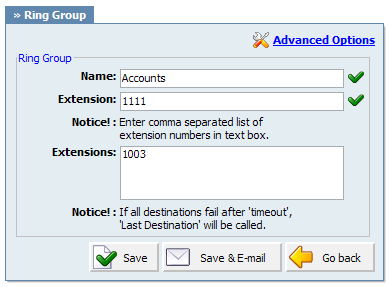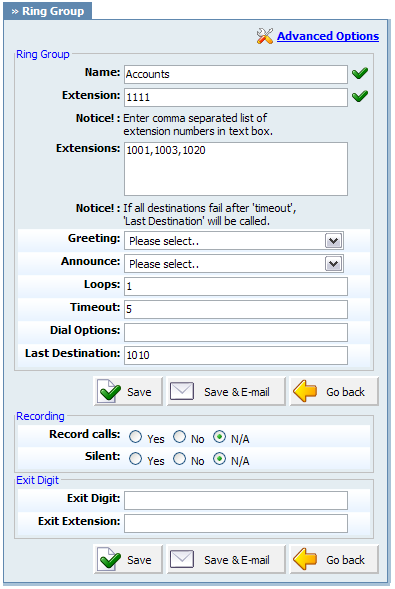Ring Groups are used to group a number of UADs/Phones into one network destination. Each Ring Group is assigned a network number which once dialed rings all extensions assigned to group.

Table 3.40. Ring Groups

Clicking on 'Add Ring Group' or 'Edit' button will open following ring group options:
Table 3.41. Add/Edit Ring Group
These options fine-tune ring group settings with additional options

Table 3.42. Advance Options
Disk Space Used By Call Recording
With continuously tone 60 seconds
-
wav49 = 84.5kb
-
wav = 833.0kb
-
gsm = 85.0kb
With continuously silent tone (without sound) 60 seconds
-
wav49 = 84.0kb
-
wav = 827.0kb
-
gsm = 84.0kb
Dial Options:
-
t - Allow the called user to transfer the call by hitting #
-
T - Allow the calling user to transfer the call by hitting #
-
r - Generate a ringing tone for the calling party, passing no audio from the called channel(s) until one answers. Use with care and don't insert this by default into all your dial statements as you are killing call progress information for the user. Really, you almost certainly do not want to use this. Asterisk will generate ring tones automatically where it is appropriate to do so. 'r' makes it go the next step and additionally generate ring tones where it is probably not appropriate to do so.
-
R - Indicate ringing to the calling party when the called party indicates ringing, pass no audio until answered. This is available only if you are using kapejod's bristuff.
-
m - Provide Music on Hold to the calling party until the called channel answers. This is mutually exclusive with option 'r', obviously. Use m(class) to specify a class for the music on hold.
-
o - Restore the Asterisk v1.0 Caller ID behaviour (send the original caller's ID) in Asterisk v1.2 (default: send this extension's number)
-
j - Asterisk 1.2 and later: Jump to priority n+101 if all of the requested channels were busy (just like behaviour in Asterisk 1.0.x)
-
M(x) - Executes the macro (x) upon connect of the call (i.e. when the called party answers)
-
h - Allow the callee to hang up by dialing *
-
H - Allow the caller to hang up by dialing *
-
C - Reset the CDR (Call Detail Record) for this call. This is like using the NoCDR command
-
P(x) - Use the Privacy Manager, using x as the database (x is optional)
-
g - When the called party hangs up, exit to execute more commands in the current context.
-
G(context^exten^pri) - If the call is answered, transfer both parties to the specified priority; however it seems the calling party is transferred to priority x, and the called party to priority x+1
-
A(x) - Play an announcement (x.gsm) to the called party.
-
S(n) - Hangup the call n seconds AFTER called party picks up.
-
d: - This flag trumps the 'H' flag and intercepts any dtmf while waiting for the call to be answered and returns that value on the spot. This allows you to dial a 1-digit exit extension while waiting for the call to be answered - see also RetryDial
-
D(digits) - After the called party answers, send digits as a DTMF stream, then connect the call to the originating channel.
-
L(x[:y][:z]) - Limit the call to 'x' ms, warning when 'y' ms are left, repeated every 'z' ms) Only 'x' is required, 'y' and 'z' are optional. The following special variables are optional for limit calls: (pasted from app_dial.c)
-
+ LIMIT_PLAYAUDIO_CALLER - yes|no (default yes) - Play sounds to the caller.
-
+ LIMIT_PLAYAUDIO_CALLEE - yes|no - Play sounds to the callee.
-
+ LIMIT_TIMEOUT_FILE - File to play when time is up.
-
+ LIMIT_CONNECT_FILE - File to play when call begins.
-
+ LIMIT_WARNING_FILE - File to play as warning if 'y' is defined. If LIMIT_WARNING_FILE is not defined, then the default behaviour is to announce ('You have [XX minutes] YY seconds').
-
-
f - forces callerid to be set as the extension of the line making/redirecting the outgoing call. For example, some PSTNs don't allow callerids from other extensions than the ones that are assigned to you.
-
w - Allow the called user to start recording after pressing *1 or what defined in features.conf, requires Set(DYNAMIC_FEATURES=automon)
-
W - Allow the calling user to start recording after pressing *1 or what defined in features.conf, requires Set(DYNAMIC_FEATURES=automon)

